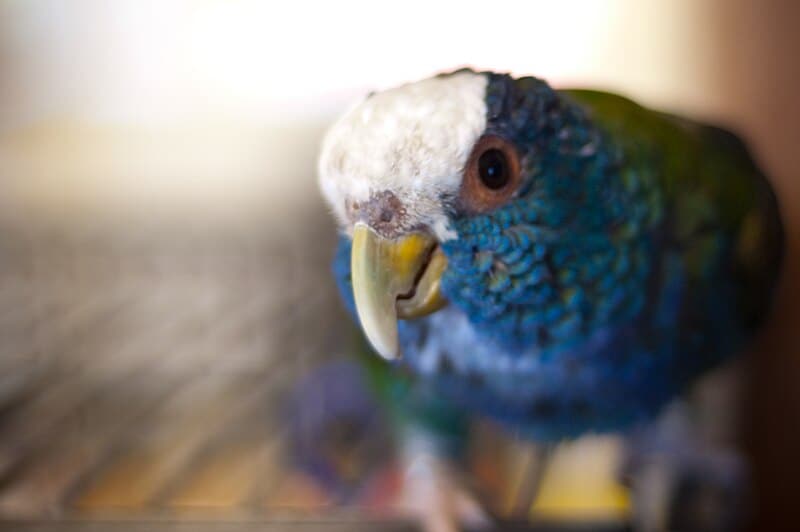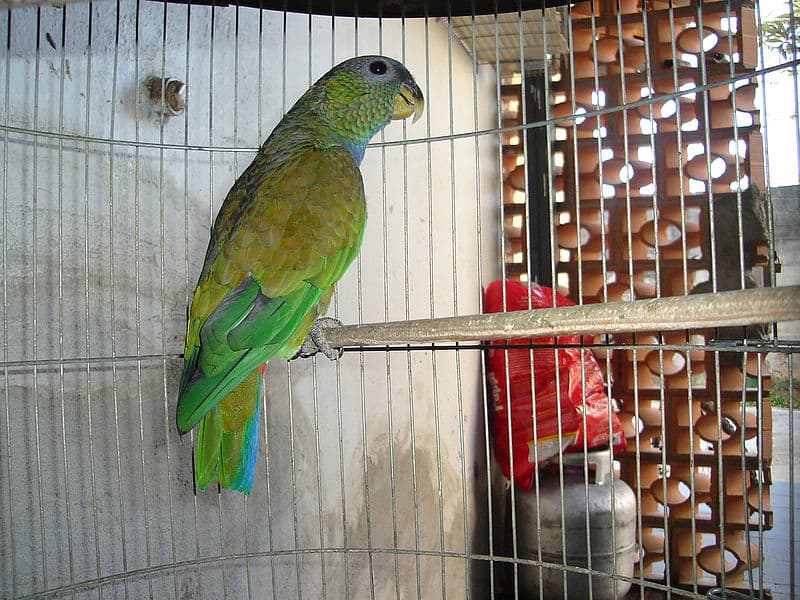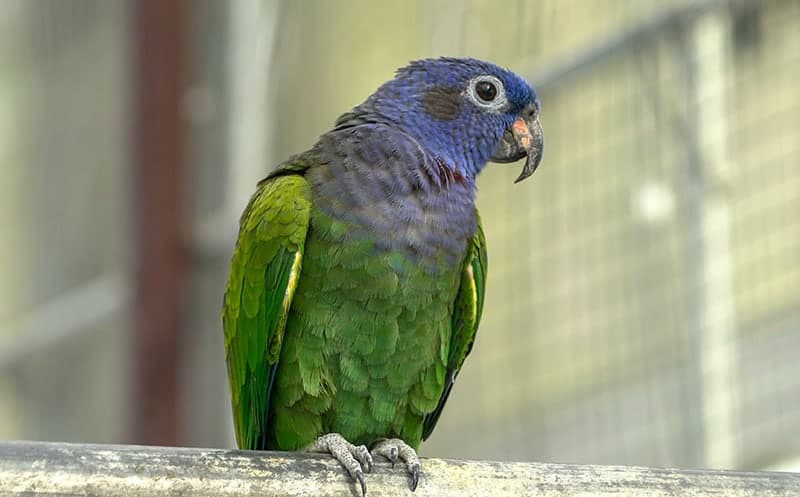Pionus parrots are similar in appearance to the smaller Amazon parrots, being short stalky birds. They can also be distinguished from the Amazon parrots by their tails. As a group, the Pionus are also known as the Red-vented Parrots, because they have bright red feathers under their tails while on the Amazons these feathers are green.
Another similarity between Amazon parrots and Pionus parrots is their behavior. Pionus have the playfulness and intelligence of the larger Amazon parrots, and the capability of learning a few words. However, Pionus are noted for being much quieter than the Amazons.
There are a number of characteristics and traits that make the Pionus very special pet birds. Pionus parrots adapt well to captivity, adjusting to their cage or aviary in just a couple weeks. They are active and inquisitive, and they enjoy attention. They also appreciate toys to keep them busy.
Pionus babies will tame quickly and a special Pionus trait is that they do not tend to bite. Another welcome Pionus trait is that they like lots of people and can become a great all-around family pet. Like all parrots though, as they mature they can bond to one person or to the people they have been raised with. A mature Pionus parrot may aggressively protect those persons from other people. This trait is suggested to be especially true of the male pionus.
- See different types of Pionus in the Pionus Parrot Family
Distribution
The Pionus parrots are from South and Central America. Different species range in many different areas. They are primarily tree top dwellers, generally found in tropical and sub-tropical forested areas.
Description
The genus Pionus contains 8 species of birds.
- Pionus Parrot Size and Shape:
The Pionus species are stocky medium-sized parrots with short square tails and a bare eye ring. Their size ranges from 9 – 12 inches in length. They are similar in appearance and behavior to the Amazon parrots, but they are smaller than most of the Amazons with the exception of the small Spectacled Amazon. - Pionus Parrot Identification
One way to distinguish a Pionus parrot from an Amazon parrot is by the tail. All Pionus parrots have red feathers under their tails while on the Amazons these feathers are green. This bright red under tail is a Pionus trait, a hallmark of the Pionus parrots, and as a group they have been referred to as the Red-vented Parrots. - Pionus Parrot Colors
Pionus Parrots acquire their lovely colorations as they mature, and by adulthood have a beautiful appearance. Though not brightly colored the Pionus parrots have many beautiful hues in their plumage. They can be likened to a painter’s palate, pulling many colors from a rainbow.
Each single bird will often be varied from another of its species in the amount and intensity of its color. This is especially true in those species without green as the main body color such as the Dusky Pionus, the Bronze-winged Pionus, and the White-crowned Pionus. However this variation is individual to each bird, and not an indication of its sex. - Pionus Parrot Sexing:
There is no visual distinction between the sexes but the young differ from their parents. The plumage on the juveniles is usually duller, with the subtle ornate coloration developing over 2 to 3 years as they mature.The sex of these birds must be determined by either a surgical probe, endoscopy, which can be done by many veterinarians; or by a DNA testing, usually a blood sample or a few plucked feathers sent to be diagnosed in a lab; or a chromosonal analysis. - Life Span of the Pionus Parrot:
The average life span for a pionus is about 22-25 years. However, there are many that live longer, some as old as 40. They are fully mature at 3 years of age.
The types of Pionus species, including some that are commonly available in the pet industry are:
- Blue-headed Parrot or Blue-headed Pionus Pionus menstruus – 2 subspecies
- Red-billed Parrot or Red-billed Pionus and Coral-billed Pionus Pionus sordidus – 5 subspecies
- Scaly-headed Parrot or Maximilian’s Pionus and Scaly-headed Pionus Pionus maximiliani – 3 subspecies
- Plum-crowned Parrot or Plum-crowned Pionus Pionus tumultuosus
- White-headed Parrot or White-headed Pionus Pionus seniloides
- White-capped Parrot / White-crowned Parrot Pionus senilis
- Bronze-winged Parrot or Bronze-winged Pionus Pionus chalcopterus – 1 subspecies
- Dusky Parrots or Dusky Pionus Pionus fuscus

Care and feeding
In the wild the Pionus parrots eat fruits, berries, seeds, possibly blossoms, and have developed a great liking for corn from cultivated fields. A Pionus diet consisting of a good parrot mix which includes formulated foods, a variety of seeds, and dried fruits is generally regarded as a suitable base to provide nutrition and variety. Along with this, provide a daily supplement of fresh fruits and vegetables.
They are active by nature and can become overweight if confined. Like the Amazon Parrots they require a low fat diet. Good Pionus bird care starts with providing a good diet.
- Bird Food:
Foods available for Pionus parrots include formulated diets, either pelleted or extruded, seed only diets, and parrot mixes which offer a mixture of both. There are pros and cons to feeding only a formulated diet as well as feeding only a seed diet.- Formulated Diet:
A formulated diet provides a good nutritional base so does not require the addition of vitamins, however it does not contain the phytonutrients (antioxidant pigments) that are found in vegetables, fruits, grains, and seeds. Phytonutrients are believed to boost the immune system, help a body to heal itself, and to prevent some diseases. Also parrots can become bored with a formulated diet due to the lack of variety. - Seed Diet:
A seed only diet offers much more variety but requires additional vitamin and calcium supplements. Variety is important in the diet for psychological enrichment.
- Formulated Diet:
- Supplements:
Supplements can include sprouted seeds, all types of fruits such as apples, pears, plums, cherries, grapes, oranges, bananas, mangos, papayas, and berries such as strawberries and blueberries. Vegetables are also good supplements such as carrots, cucumbers, zucchini, many garden vegetables, and even dandelions and chickweed. Do not feed avocado as it may be toxic to birds! - Water:
Give your Pionus fresh drinking water every day. - Bird Baths:
The personal hygiene of your Pionus parrot includes a regular shower for good plumage and skin condition. Pionus dearly love the rain and will even turn upside down, spreading and flapping their wings in grand enjoyment of this natural shower. One way to accomplish a shower indoors or in an aviary is with either a hand held shower sprayer or a hose with a fine spray head and lukewarm water. - Bird Grooming:
- Wings:
The wings should be kept trim if you want to discourage flight and to prevent the loss of your pet through an open window or door. - Beak:
The beak needs to be trimmed if it becomes overgrown or deformed, however it is typical for the upper beak of the pionus to be quite long compared to that of other parrots. There are many mineral blocks, lava blocks, and other beak grooming items available at your pet store to help your bird keep its beak in shape. - Nails:
A variety of concrete-type perches are also available to help keep the nails trim, but they should be trimmed if they become overgrown. Bird nail trimmers and styptic powder to stop the bleeding are also available at pet shops and online.
- Wings:
Housing
Pionus quickly adapt to their cage and environment. The majority of Pionus are kept in a cage in the home, in a bird room, or in an aviary. Bird cages must not be too confining, so get one that your pet will be able to feel comfortable in. You will need dishes for food, water, and treats.
- Bird Cages:
A cage best suited to house a Pionus parrot would be similar to that required by an Amazon parrot. It can be between 39″- 59″ (100-150 cm) high and have a floor space of 23″x 39″ (60 x 100 cm), though it has been suggested that a minimum size cage could be 24″x 24″x 32″ (62 x 62 x 83 cm). 3/4″ bar spacing is recommended, though 1″ bar spacing is okay for the larger pionus.
The cage needs to provide room for lots of movement as well as space for perches, food dishes and a variety of playthings. Playthings can include climbing ropes, chains, bells, parrot swings and wooden or other bird toys. A playpen is ideal for playtime outside of the cage. - Aviary:
Pionus, once acclimated, can do very well in an outdoor or breeding aviary. However they do not all tolerate colder temperatures. For example the Bronze-winged Pionus should not be kept where temperatures fall below 41° F(5° C), and the Dusky Pionus which should not be kept below 50 ° F (10° C).
An outdoor aviary needs to have a protected shelter that can be heated and cooled where necessary and have an attached flight cage. It is recommended that it be 6 – 8 feet 12′ (180 – 240 cm) long with a perch at each end. The width is not as important for just a pair of birds so 3′ – 4′ (90 – 120 cm) would be fine. A climbing branch and a bird bath are nice additions too.
Maintenance
The basic cage care includes daily cleaning of the water and food dishes. Weekly you should wash all the perches and dirty toys, and the floor should be washed about every other week. A total hosing down and disinfecting of an aviary should be done yearly, replacing anything that needs to be freshened, such as old dishes, toys and perches.
Social Behaviors
In the wild Pionus parrots are seen in small or medium-sized flocks when not breeding, about 10 to 60 birds. During breeding season they are generally seen singly or in pairs.
In captivity Pionus parrots are generally peaceful and not particularly loud. A nice Pionus trait is that they are usually calm birds though some can be a bit more nervous. Usually, this is only when first introduced to a new environment and passes as they become more confident. There is some thought that the females are more gentle than the males.
They are very social birds and are often considered the most ideal parrot to have as a pet, particularly when children are involved. They have good steady personalities and are loyal. A favorite Pionus trait is that they rarely bite. They can also do well with other pets if they get used to and accept each other. However be very careful to monitor all groupings with animals and with children to prevent any unexpected accidents.

Handling/Training
A hand-raised Pionus makes a delightful pet, but like all parrots it needs a bit of time to become accustomed to its new environment. Your Pionus may seem a bit standoffish when you first bring it home, but it is just being quiet and reserved until it has checked out its new surroundings and feels secure.
- Taming Basics:
Though a Pionus parrot is quick to adapt to its new home, you should give a new arrival a few days to get use to you, your voice and its cage before trying to handle it. A hand fed baby will not need much taming and can often be handled right away, as it is use to human attention.
To be able to handle and train your parrot depends first on trust, so go slowly and be consistent. Many parrots are most receptive to bird training in the evening and each session is best if limited to under 20 minutes with about an hour rest in between.
Remember that bird taming and bird training takes patience, never ‘punish’ you parrot! This only serves to destroy the trust you’ve spent so much time building. - Initial Training:
Your first goal is to get the parrot to accept a treat from you, which will lead to it allowing you to gently scratch its head. Then you can begin to work on getting your parrot to step up on your hand. Depending on the tameness of the bird, these two steps can be instantaneous as in a hand fed baby or take several weeks or longer for an untamed bird.
Pionus are not extremely cuddly birds but they do love having their head, ears, and neck scratched. - Advanced Training:
Once your Pionus parrot has gotten over its shyness, you can work on speech training. Repetition and frequency are the keys here to get your Pionus parrot talking. Almost every parrot can learn at least a few words, although unlike the African Grey, their mimicry sounds rather ‘parrot-like’.
For an extensive parrot training system that potentially turns your bird into a fun, loving companion as well as learning lots of cool tricks, try Chet Womach’s Parrot Training Course.
Activities
Exercise and play are important activities for the physical well being and psychological health of your Pionus. They are active by nature and may become overweight they become too sedentary. Activities also help deter stress and prevent problems such as screaming. Provide your parrot with lots of activities in the form of large link chains, bird ladders, parrot swings, ropes, fresh branches for gnawing and chewing, and rotate new bird toys on a regular basis.
Breeding/Reproduction
Successful breeding is helping to preserve the species and reduce the number of wild caught birds. There are no breeding regulations in the United States, Canada, or the United Kingdom, though other countries might have restrictions and you should consult with the authorities in your country before undertaking breeding.
- Sexing Amazon Parrots:
Pionus parrots are not dimorphic and you will have to have them sexed by either a surgical probe, endoscopy, a DNA test, or a chromosonal analysis. The sexes must be confirmed and the pair must be harmonious, bonded with each other. Some species of Pionus have been successfully bred in captivity while others are quite nervous and difficult to breed. - Breeding Environment:
Pionus parrots should be bred in flight cages. They will need a nest box that is about 10″ x 10″ x 20″ (25 x 25 x 50 cm) and have some soft bedding material inside on the bottom of the box. The opening needs to be approximately the width of the broadest part of the parrots back. Because some pionus are rather nervous, it is generally recommended that the nest box be mounted in covered darkened areas as high as you can, to encourage breeding. - Egg Laying and Hatchlings:
A Pionus female may lay up to 5 eggs and she will brood for about 26 days. The young will leave the nest at about 8 – 14 weeks of age, depending on the species.
Potential Problems
As with all parrots, provide good bird health care. Parrot problem will be averted if you offer them a good environment and get familiar with your pet so you can spot any signs of illness. An ailing parrot should be taken to a avian veterinarian for diagnosis and treatment.
As with all parrots, signs of illness to be aware of are ruffled plumage, resting often with their head turned back, having no appetite, sneezing, discharge from the nostrils, cloudy eyes, and any change in the feces.
Pionus parrots will make a wheezing sound when they are scared or excited. This is totally normal and does not indicate a sick bird. However, Pionus parrots are also known to be more prone to aspergillosis than other parrots. Aspergillosis can have the same symptoms as those exhibited by a scared or excited Pionus. As you get to know your bird, you will be able to distinguish between the two.
Some of the common illnesses your Pionus could contract are internal parasites, bacterial and fungal infections, intestinal influenza, coccidiosis, respiratory ailments, aspergillosis, feather picking, poor eating habits, vitamin A deficiency, toxicity, ingestion of metals, parrot fever also known as psittacosis, and p0x virus infections (generally only found in imported birds). An ailing parrot should be taken to a avian veterinarian for diagnosis and treatment.
Behavior problems usually stem from something missing in the bird’s environment. Boredom, lack of trust, lack of interaction with other birds or people can lead to problems like biting, feather plucking, and screaming. Try to develop a bond of trust and spend time with your bird to help avoid these problems.
We have also had good success with Chet Womach’s Parrot Training Course. He offers a free 3-day introductory course so you can try it out before you buy anything.

Availability
Of the eight species of Pionus parrots, five species are frequently available as captive raised pets in the United States. The regular Pionus for sale include the Blue-headed Pionus, the Bronze-winged Pionus, the Maximilian’s Pionus or Scaly-headed Parrot, the Dusky Pionus, and the White-capped Parrot or White-crowned Pionus. As breeding becomes more successful, the Pionus species are becoming more available
The remaining three species of Pionus are very rare and not readily available at this time. The unavailable or rare Pionus for sale are the Plum-crowned Parrot (Plum-crowned Pionus or Restless Parrot) Pionus tumultuosus, the Red-billed Parrot (Coral-billed Pionus or Sordid Pionus) Pionus sordidus, and the White-headed Parrot (White-headed Pionus or Massena’s Parrot) Pionus seniloides.
Featured Image Credit: Swaroop Pixs, Shutterstock
